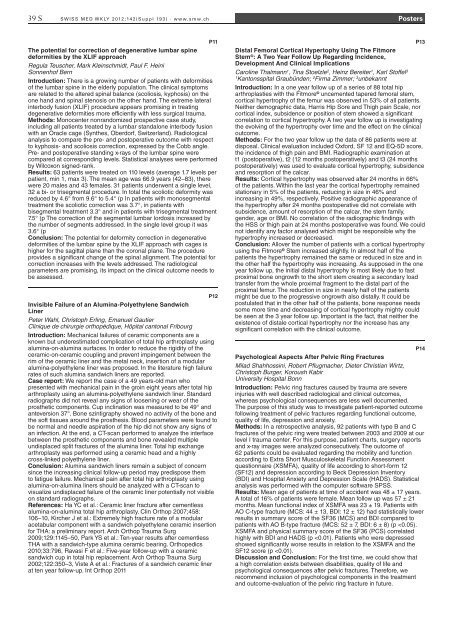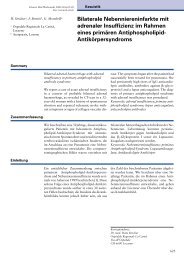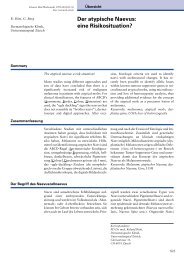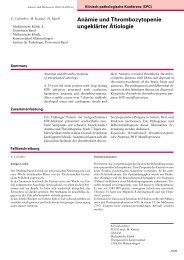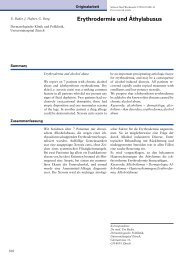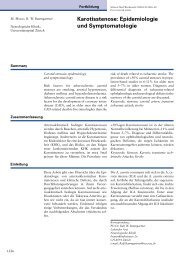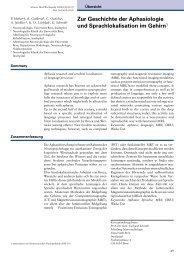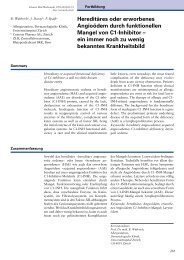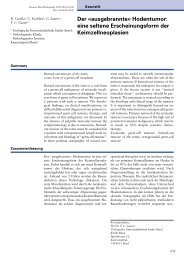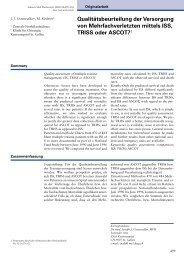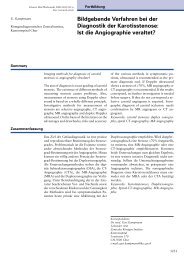SMW Supplementum 193 - Swiss Medical Weekly
SMW Supplementum 193 - Swiss Medical Weekly
SMW Supplementum 193 - Swiss Medical Weekly
You also want an ePaper? Increase the reach of your titles
YUMPU automatically turns print PDFs into web optimized ePapers that Google loves.
39 S SWiSS Med Wkly 2012;142(Suppl <strong>193</strong>) · www.smw.ch Posters<br />
P11<br />
The potential for correction of degenerative lumbar spine<br />
deformities by the XLIF approach<br />
Regula Teuscher, Mark Kleinschmidt, Paul F. Heini<br />
Sonnenhof Bern<br />
Introduction: There is a growing number of patients with deformities<br />
of the lumbar spine in the elderly population. The clinical symptoms<br />
are related to the altered spinal balance (scoliosis, kyphosis) on the<br />
one hand and spinal stenosis on the other hand. The extreme lateral<br />
interbody fusion (XLIF) procedure appears promising in treating<br />
degenerative deformities more efficiently with less surgical trauma.<br />
Methods: Monocenter nonrandomized prospective case study,<br />
including all patients treated by a lumbar standalone interbody fusion<br />
with an Oracle cage (Synthes, Oberdorf, Switzerland). Radiological<br />
analysis to compare the pre- and postoperative outcome with respect<br />
to kyphosis- and scoliosis correction, expressed by the Cobb angle.<br />
Pre- and postoperative standing x-rays of the lumbar spine were<br />
compared at corresponding levels. Statistical analyses were performed<br />
by Wilcoxon signed-rank.<br />
Results: 63 patients were treated on 110 levels (average 1.7 levels per<br />
patient, min 1, max 3). The mean age was 66.9 years (42–83), there<br />
were 20 males and 43 females. 31 patients underwent a single level,<br />
32 a bi- or trisegmental procedure. In total the scoliotic deformity was<br />
reduced by 4.6° from 9.6° to 5.4° (p In patients with monosegmental<br />
treatment the scoliotic correction was 3.7°, in patients with<br />
bisegmental treatment 3.3° and in patients with trisegmental treatment<br />
7.5° (p The correction of the segmental lumbar lordosis increased by<br />
the number of segments addressed. In the single level group it was<br />
3.6° (p<br />
Conclusion: The potential for deformity correction in degenerative<br />
deformities of the lumbar spine by the XLIF approach with cages is<br />
higher for the sagittal plane than the coronal plane. The procedure<br />
provides a significant change of the spinal alignment. The potential for<br />
correction increases with the levels addressed. The radiological<br />
parameters are promising, its impact on the clinical outcome needs to<br />
be assessed.<br />
P12<br />
Invisible Failure of an Alumina-Polyethylene Sandwich<br />
Liner<br />
Peter Wahl, Christoph Erling, Emanuel Gautier<br />
Clinique de chirurgie orthopédique, Hôpital cantonal Fribourg<br />
Introduction: Mechanical failures of ceramic components are a<br />
known but underestimated complication of total hip arthroplasty using<br />
alumina-on-alumina surfaces. In order to reduce the rigidity of the<br />
ceramic-on-ceramic coupling and prevent impingement between the<br />
rim of the ceramic liner and the metal neck, insertion of a modular<br />
alumina-polyethylene liner was proposed. In the literature high failure<br />
rates of such alumina sandwich liners are reported.<br />
Case report: We report the case of a 49 years-old man who<br />
presented with mechanical pain in the groin eight years after total hip<br />
arthroplasty using an alumina-polyethylene sandwich liner. Standard<br />
radiographs did not reveal any signs of loosening or wear of the<br />
prosthetic components. Cup inclination was measured to be 49° and<br />
anteversion 37°. Bone szintigraphy showed no activity of the bone and<br />
the soft tissues around the prosthesis. Blood parameters were found to<br />
be normal and needle aspiration of the hip did not show any signs of<br />
an infection. At the end, a CT-scan performed to analyze the interface<br />
between the prosthetic components and bone revealed multiple<br />
undisplaced split fractures of the alumina liner. Total hip exchange<br />
arthroplasty was performed using a ceramic head and a highly<br />
cross-linked polyethylene liner.<br />
Conclusion: Alumina sandwich liners remain a subject of concern<br />
since the increasing clinical follow-up period may predispose them<br />
to fatigue failure. Mechanical pain after total hip arthroplasty using<br />
alumina-on-alumina liners should be analyzed with a CT-scan to<br />
visualize undisplaced failure of the ceramic liner potentially not visible<br />
on standard radiographs.<br />
References: Ha YC et al.: Ceramic liner fracture after cementless<br />
alumina-on-alumina total hip arthroplasty. Clin Orthop 2007;458:<br />
106–10, Kircher J et al.: Extremely high fracture rate of a modular<br />
acetabular component with a sandwich polyethylene ceramic insertion<br />
for THA: a preliminary report. Arch Orthop Trauma Surg<br />
2009;129:1145–50, Park YS et al.: Ten-year results after cementless<br />
THA with a sandwich-type alumina ceramic bearing. Orthopedics<br />
2010;33:796, Ravasi F et al.: Five-year follow-up with a ceramic<br />
sandwich cup in total hip replacement. Arch Orthop Trauma Surg<br />
2002;122:350–3, Viste A et al.: Fractures of a sandwich ceramic liner<br />
at ten year follow-up. Int Orthop 2011<br />
P13<br />
Distal Femoral Cortical Hypertophy Using The Fitmore<br />
Stem © : A Two Year Follow Up Regarding Incidence,<br />
Development And Clinical Implications<br />
Caroline Thalmann1 , Tina Stoelzle2 , Heinz Bereiter1 , Karl Stoffel3 1 2 3 Kantonsspital Graubünden; Firma Zimmer; unbekannt<br />
Introduction: In a one year follow up of a series of 88 total hip<br />
arthroplasties with the Fitmore © uncemented tapered femoral stem,<br />
cortical hypertrophy of the femur was observed in 53% of all patients.<br />
Neither demographic data, Harris Hip Sore and Thigh pain Scale, nor<br />
cortical index, subsidence or position of stem showed a significant<br />
correlation to cortical hypertrophy. A two year follow up is investigating<br />
the evolving of the hypertrophy over time and the effect on the clinical<br />
outcome.<br />
Methods: For the two year follow up the data of 86 patients were at<br />
disposal. Clinical evaluation included Oxford, SF 12 and EQ-5D score,<br />
the incidence of thigh pain and BMI. Radiographic examination at<br />
t1 (postoperative), t2 (12 months postoperatively) and t3 (24 months<br />
postoperatively) was used to evaluate cortical hypertrophy, subsidence<br />
and resorption of the calcar.<br />
Results: Cortical hypertrophy was observed after 24 months in 66%<br />
of the patients. Within the last year the cortical hypertrophy remained<br />
stationary in 5% of the patients, reducing in size in 46% and<br />
increasing in 49%, respectively. Positive radiographic appearance of<br />
the hypertrophy after 24 months postoperative did not correlate with<br />
subsidence, amount of resorption of the calcar, the stem family,<br />
gender, age or BMI. No correlation of the radiographic findings with<br />
the HSS or thigh pain at 24 months postoperative was found. We could<br />
not identify any factor analysed which might be responsible why the<br />
hypertrophy increased or decreased.<br />
Conclusion: Allover the number of patients with a cortical hypertrophy<br />
using the Fitmore © Stem increased slightly. In almost half of the<br />
patients the hypertrophy remained the same or reduced in size and in<br />
the other half the hypertrophy was increasing. As supposed in the one<br />
year follow up, the initial distal hypertrophy is most likely due to fast<br />
proximal bone ongrowth to the short stem creating a secondary load<br />
transfer from the whole proximal fragment to the distal part of the<br />
proximal femur. The reduction in size in nearly half of the patients<br />
might be due to the progressive ongrowth also distally. It could be<br />
postulated that in the other half of the patients, bone response needs<br />
some more time and decreasing of cortical hypertrophy mighty could<br />
be seen at the 3 year follow up. Important is the fact, that neither the<br />
existence of distale cortical hypertrophy nor the increase has any<br />
significant correlation with the clinical outcome.<br />
P14<br />
Psychological Aspects After Pelvic Ring Fractures<br />
Milad Shahhossini, Robert Pflugmacher, Dieter Christian Wirtz,<br />
Christoph Burger, Koroush Kabir<br />
University Hospital Bonn<br />
Introduction: Pelvic ring fractures caused by trauma are severe<br />
injuries with well described radiological and clinical outcomes,<br />
whereas psychological consequences are less well documented.<br />
The purpose of this study was to investigate patient-reported outcome<br />
following treatment of pelvic fractures regarding functional outcome,<br />
quality of life, depression and anxiety.<br />
Methods: In a retrospective analysis, 92 patients with type B and C<br />
fractures of the pelvic ring were treated between 2003 and 2009 at our<br />
level I trauma center. For this purpose, patient charts, surgery reports<br />
and x-ray images were analyzed consecutively. The outcome of<br />
62 patients could be evaluated regarding the mobility and function<br />
according to Extra Short Musculoskeletal Function Assessment<br />
questionnaire (XSMFA), quality of life according to short-form 12<br />
(SF12) and depression according to Beck Depression Inventory<br />
(BDI) and Hospital Anxiety and Depression Scale (HADS). Statistical<br />
analysis was performed with the computer software SPSS.<br />
Results: Mean age of patients at time of accident was 48 ± 17 years.<br />
A total of 16% of patients were female. Mean follow up was 57 ± 21<br />
months. Mean functional index of XSMFA was 23 ± 19. Patients with<br />
AO C-type fracture (MCS: 44 ± 13, BDI: 12 ± 12) had statistically lower<br />
results in summary score of the SF36 (MCS) and BDI compared to<br />
patients with AO B-type fracture (MCS: 52 ± 7, BDI: 6 ± 8) (p


